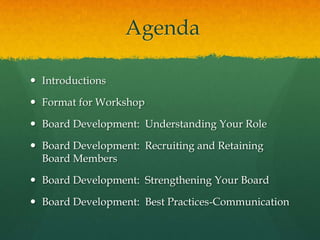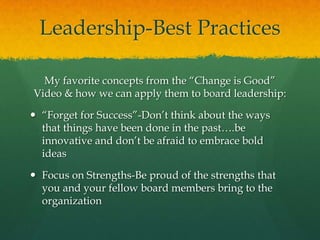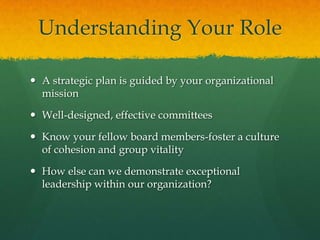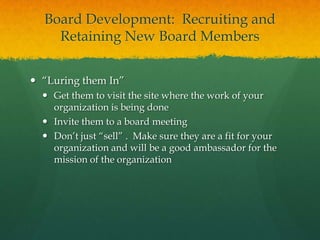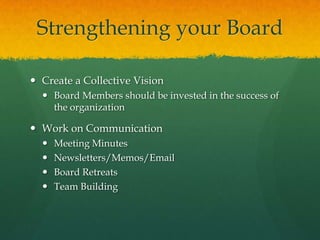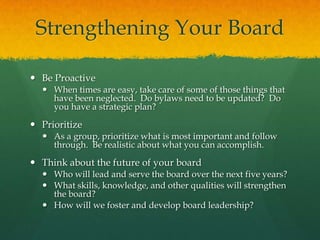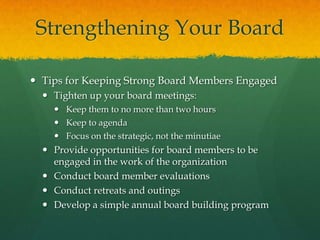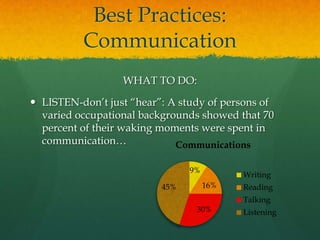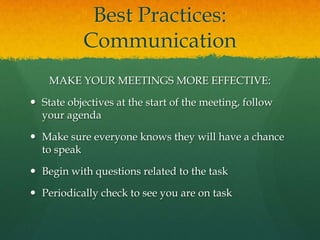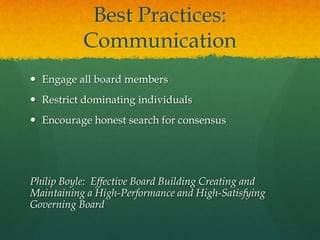Board development for non profit organizations
- 1. Board Development for Non-Profit Organizations Rachel Weber ENMU-Ruidoso Community Education Wednesday, August 21, 2013
- 2. Agenda Introductions Format for Workshop Board Development: Understanding Your Role Board Development: Recruiting and Retaining Board Members Board Development: Strengthening Your Board Board Development: Best Practices-Communication
- 3. Format of Presentation Be involved and engaged Think of this as a two hour conversation about your board Ask questions Give your opinion
- 5. Understanding Your Role & Leadership
- 6. Leadership-Best Practices My favorite concepts from the “Change is Good” Video & how we can apply them to board leadership: “Forget for Success”-Don’t think about the ways that things have been done in the past….be innovative and don’t be afraid to embrace bold ideas Focus on Strengths-Be proud of the strengths that you and your fellow board members bring to the organization
- 7. Leadership-Best Practices Simplify your message-FOCUS on your mission Let your actions speak-BE the voice of your organization everywhere in the community Celebrate success-use every opportunity you can to share the news of your organization’s successes Measure Results-”what gets measured, gets improved”
- 8. Understanding your Role The Board of Directors should provide leadership for the organization Roles, responsibilities, and powers are usually outlined in bylaws Members should fully understand their roles and responsibilities Members have diverse backgrounds but share common goals
- 9. Understanding Your Role Every organization should have a formal Board Policy Manual Board Members should be aware of current policies Volunteer-Be a part of your organization’s events. Don’t just show up for meetings once a month Look out for the best interest of the organization
- 10. Understanding Your Role The Board of Directors should foster a transparent, consistent, and accountable culture Always have your financial records audited by an outside agency Focus on results. What is your mission? How can you measure progress? Understand the importance of fresh perspectives Develop a conflict of interest policy Documentation: Minutes, notes, receipts, handbooks, presentations
- 11. Leadership Best Practices Stay “Mission Driven”. What is our mission? Maintain consistency Be strategic. Spend your time wisely. Focus on the things that are important. Continuously review your Board of Directors’ best practices; evaluate your board’s performance and effectiveness Board members represent the organization within the community
- 12. Understanding Your Role Annually review your organization’s mission Board orientation-continuing education Report on programs and services & track progress Actively solicit input from the community Represent the organization to government, business, other agencies, funders, and the community at large Support healthy and productive relationships throughout the organization
- 13. Understanding Your Role A strategic plan is guided by your organizational mission Well-designed, effective committees Know your fellow board members-foster a culture of cohesion and group vitality How else can we demonstrate exceptional leadership within our organization?
- 14. Understanding Your Role Ways To Increase Your Success As A Board Member Attend all meetings of the board and committees on which you serve. Come prepared to discuss the issues and business to be addressed at scheduled meetings, having read the agenda and all background material. Work with and respect the opinions of peers who serve this board, and to leave personal prejudices out of all board discussions. Always act for the good of the organization and represent the interests of all people served by this nonprofit.
- 15. Understanding Your Role Represent this organization in a positive and supportive manner at all times. Observe the parliamentary procedures and display courteous conduct in all board, committee and task force meetings. Avoid conflict of interest between my position as a board member and my personal life. This includes using your position for the advantage of friends and business associates. If such a conflict does arise, declare that conflict before the board and refrain from voting on matters in which you have conflict.
- 16. Understanding Your Role Determine the Organization’s Mission and Purpose Select the Executive Director Support the Executive and Review His/Her Performance Ensure Effective Organizational Planning Ensure Adequate Resources Manage Resources Effectively Determine and Monitor the Organization’s Programs and Services Enhance the Organizations Public Image
- 17. Understanding Your Role Serve as Court of Appeal Assess its Own Performance Assumptions Board and board member responsibilities are fundamentally the same for all organizations How boards and board member responsibilities actually fulfill their responsibilities will vary There is no generic model All organization undergo a metamorphosis Board members begin to reach their optimal levels of performance when they exercise their responsibilities by asking good and timely questions rather than by running programs or implementing their own policies From the Ten Basic Responsibilities of Nonprofit Boards. Washington, DC: National Center for Nonprofit boards. Ingram, Richard T.
- 18. Board Development: Recruiting and Retaining New Members Question for the group: where does your organization look for new board members?
- 19. Board Development: Recruiting and Retaining New Board Members “Luring them In” Get them to visit the site where the work of your organization is being done Invite them to a board meeting Don’t just “sell” . Make sure they are a fit for your organization and will be a good ambassador for the mission of the organization
- 20. Board Development: Recruiting and Retaining New Board Members Determining a good fit Explicitly ask them if they are prepared to use the skill you are recruiting them for Have more than one person meet/interview them Make sure they understand the job description Develop a quantifiable rubric to compare candidates
- 21. Board Development: Recruiting and Retaining New Board Members See Rubric Example
- 22. Board Development: Recruiting and Retaining New Board Members If you are unsure, start them on a committee to see how they do Consider a mandatory committee assignment prior to becoming a full board member
- 23. Questions to ask/Application Process Do you have a protocol for the board member application process? What Skills and Expertise do you look for? Is your application tool a good vehicle for finding these skills and expertise? See attached worksheet: “Questions to ask Potential Board Candidates”
- 24. Retaining Board Members Board Manual Well planned, organized, pockets to hold brochures, dated materials, current, updateable, easy to use, reasonable size, done with input & consultation by Board Names & Bio of Board Members & Statements of Responsibility of officers List of Committees History or fact sheet of organization Articles of Incorporation and ByLaws Mission and Vision Statements
- 25. Retaining board members Strategic plan Minutes Policies Annual & audit report from prior year Current budget and latest financial statement List of major funders and partners Organizational Chart & Staff Info Annual Calendar Promotional and Website info
- 26. Strengthening your Board Create a Collective Vision Board Members should be invested in the success of the organization Work on Communication Meeting Minutes Newsletters/Memos/Email Board Retreats Team Building
- 27. Strengthening Your Board Be Proactive When times are easy, take care of some of those things that have been neglected. Do bylaws need to be updated? Do you have a strategic plan? Prioritize As a group, prioritize what is most important and follow through. Be realistic about what you can accomplish. Think about the future of your board Who will lead and serve the board over the next five years? What skills, knowledge, and other qualities will strengthen the board? How will we foster and develop board leadership?
- 28. Strengthening Your Board Tips for Keeping Strong Board Members Engaged Tighten up your board meetings: Keep them to no more than two hours Keep to agenda Focus on the strategic, not the minutiae Provide opportunities for board members to be engaged in the work of the organization Conduct board member evaluations Conduct retreats and outings Develop a simple annual board building program
- 29. Board Development: Communication Effective communication makes your meetings more productive
- 30. Best Practices: Communication What NOT to do? Lack of patience Poor behavior or “acting out” Not “seeing the forest for the trees” Personal or hidden agendas Getting stuck in alliances and coalitions regardless of the issue Lack of ground rules Ways of speaking to other board members that are hurtful or close down communication
- 31. Best Practices: Communication (Lecturing, chastising, threatening, bullying, etc.) Competition, turf, fairness, zero-sum games, winners and losers Too much talking, not enough listening Too little leadership and skills building Disengagement from community “Effective Board Building”, by Phillip Boyle
- 32. Best Practices: Communication What do these “don’ts” lead to? Unsatisfying communication Diminished trust, respect, acceptance, tolerance Increased stress Loss of community respect, difficulty getting things accomplished Lose sight of Purpose
- 33. Best Practices: Communication WHAT TO DO: LISTEN-don’t just “hear”: A study of persons of varied occupational backgrounds showed that 70 percent of their waking moments were spent in communication… 9% 16% 30% 45% Communications Writing Reading Talking Listening
- 34. Best Practices: Communication Unfortunately, even at the purely informational level, researchers claim that 75% of oral communication is ignored, misunderstood, or quickly forgotten.
- 35. Best Practices: Communication Robert Bolton, People Skills author describes three listening skill clusters for enhancing communications: Attending Skills: A posture of involvement, appropriate body motion, eye contact, and non-distracting environment Following Skills: Door Openers, Minimal Encourages, Infrequent Questions, Attentive Silence Reflecting Skills: Paraphrasing, Reflecting Feelings, Reflecting Meanings, Summative Reflections
- 36. Best Practices: Communication Meetings are central to an organizational board’s functioning. They can also breed arguments and long discussions that lead nowhere and fail to produce results.
- 37. Best Practices: Communication MAKE YOUR MEETINGS MORE EFFECTIVE: Ask Open-Ended Questions: this can help members to identify their own solutions to problems Ask for specifics Use writing as a communication tool Turn “US” and “THEM” into “WE” Listen attentively and acknowledge Establish realistic expectations Don’t pressure others to see things your way, but rather to be responsible for their own actions. “Effective Board Building”-Philip Boyle
- 38. Best Practices: Communication MAKE YOUR MEETINGS MORE EFFECTIVE: State objectives at the start of the meeting, follow your agenda Make sure everyone knows they will have a chance to speak Begin with questions related to the task Periodically check to see you are on task
- 39. Best Practices: Communication Don’t reinforce or explore off-task remarks Use close-ended questions to address off-task remarks, then tactfully ask the person who has made it to relate their comment to the task at hand Ask how to improve the next meeting, then incorporate one new idea Summarize and reflect ideas MODEL desired behaviors
- 40. Best Practices: Communication Engage all board members Restrict dominating individuals Encourage honest search for consensus Philip Boyle: Effective Board Building Creating and Maintaining a High-Performance and High-Satisfying Governing Board
- 41. Closing Thoughts on Communication Questions to ask ourselves: Are we clear about our purpose? How satisfied are we with our communication processes? Do disagreements become personal? Do we share responsibility for leading our board? Are we treating each other fairly?
- 42. Final Thoughts: Strategies for Improving Meetings Set the context for issues and discussions Distinguish between routine and strategic issues Distinguish between governance and management Facilitate the discussion and monitor participation Don’t delegate to committees until the board has outlined a process and set the context and parameters for the work. Meetinghouse Solutions, 2006
- 43. Improving meetings- Minutes Meeting minutes are a record of what was done at the meeting, not what everyone said. Meeting minutes are legal documents than auditors and others may review. They should be accurate, brief, and easy to read Format: Include the name of the organization, date, time and location of the meeting. Note whether it is a special or regular meeting. List those who are present and who are absent, as well as guests. Meetinghouse Solutions, 2006
- 44. Meeting minutes continued Specify the time the meeting was convened at the name of the presiding officer. Record minutes in accordance with the order of events. Note the approval and amendment of the minutes of the previous meeting as well as the review and acceptance of the financial report. Summarize the main points of discussion only if it sets precedent or is critical. Otherwise, simply note that “discussion ensued”. Identify problems and suggestions, record all motions and abstentions. Note the time of adjournment. Meetinghouse Solutions, 2006


